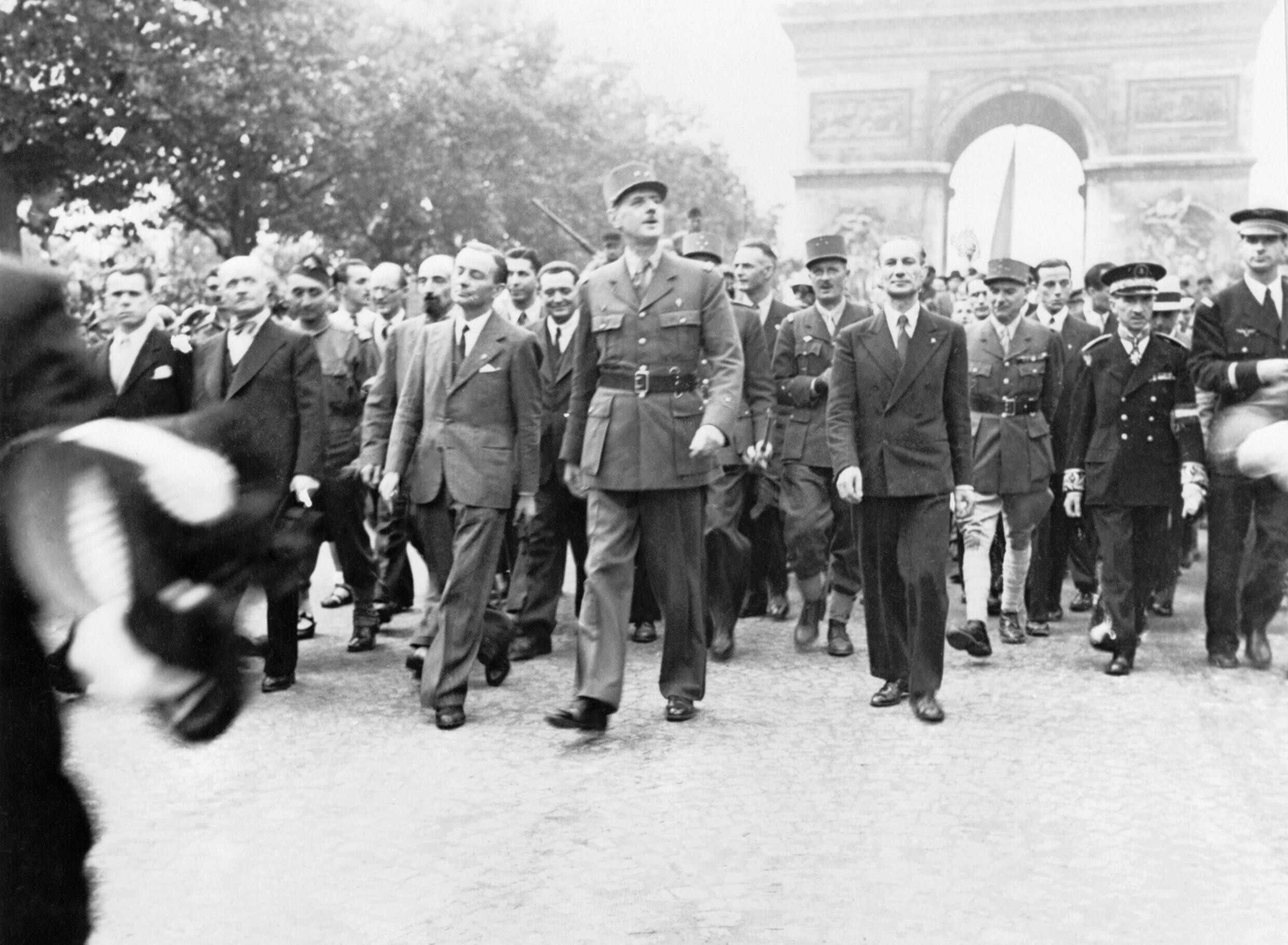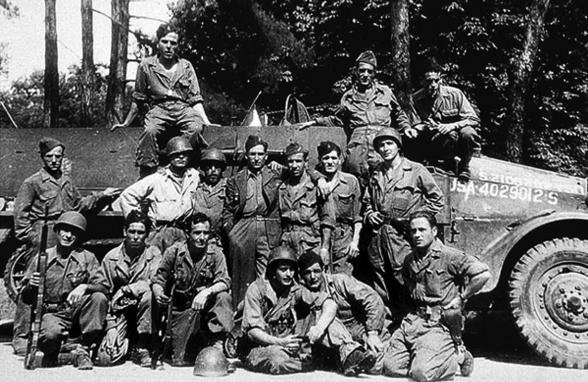Setting the Record Straight: The Liberation of Paris, August 25, 1944

The Liberation of Paris, 25 – 26 August 1944. General Charles de Gaulle and his entourage set off from the Arc de Triomphe down the Champs Elysees to Notre Dame for a service of thanksgiving following the city’s liberation in August 1944. London: Imperial War Museum. Public domain.
The half-tracks of the French Second Armored Division that entered Paris in August 1944 were baptized “Brunete,” “Guadalajara,” “Teruel,” or “L’Ebre,” and manned by Spanish exiles. Some 500 Spanish Loyalists served in the Leclerc Division. Yet the official story of the Liberation of Paris has always presented the battle as a purely French affair.
In the morning of August 25, 1944, as Colonel Rol, commander of the French Resistance in and around Paris, crossed the Place de l’Hôtel de Ville, he couldn’t help but think that history had suddenly come full circle. For what was to be the battle for Paris, Henri Tanguy, or Colonel Rol, had donned the only uniform he owned, that of commissar of the XIV International Brigade of the Spanish Republican Army. His nom de guerre was also related to that earlier struggle where his friend, Captain Theodule Rol, commander of the Comune de Paris battalion had been killed in the Sierra Cavals in September 1938. In fact, across occupied France someone with a past in the International Brigades was a guarantee of stead-worthiness and many commanders of the resistance movement had begun their fight against fascism in Spain.
Colonel Rol was well aware of the links between Spain and the Resistance, so what was it that morning that caused him to muse that history had come full circle, back to where it had started? It was, in fact, the surprising names of the vehicles of the vanguard of the French Second Armored Division that had entered the city the night before and had taken position around the Town Hall. Half-tracks baptized “Brunete,” “Guadalajara,” “Teruel” or “L’Ebre,” manned predominantly by Spanish Loyalist exiles, were an unmistakable reference to that earlier war. In addition, at least one vehicle, the half-tack “Santander,” bore a small Spanish Loyalist flag above the driver’s compartment.
Five and a half years earlier at the close of the Spanish Civil War in March 1939, these men had escaped to North Africa and had subsequently taken up arms with the Free French in 1943. They eventually found themselves in one of the most famed units of the Fighting French Army led by the charismatic General Leclerc. The symbolic full circle was thus a former IB brigade commissar who had fought in civilian clothes since 1940, who had slipped into his Spanish Loyalist Army uniform for the battle of Paris unexpectedly meeting up with Spanish Loyalist veterans in the French Army on the steps of the Hôtel de Ville readying themselves for the final blow against the Nazi occupiers. Approximately 500 Spanish Loyalists served in the Leclerc Division, chiefly in the third battalion of the Régiment de Marche du Tchad, most notably in the 9th Company, referred to throughout the division as la Nueve due to its discernable Spanish essence.

The crew of the halftrack “Guadalajara Nº 2” & others in Paris shortly after the liberation. Archivo Histórico del Partido Comunista de España.
The role of la Nueve in one of the first acts of the liberation of Paris began with a fortuitous encounter near the town of Antony seven kilometers to the south of Paris. On the afternoon of August 24, when French and American units were grappling with German strong points in the southern suburbs and the resistance groups under Colonel Rol were defending barricades across the city with increasing difficulty, the impatient General Leclerc came across Captain Raymond Dronne, one of his subordinates since 1940 and commander of la Nueve. Leclerc ordered Dronne into Paris on what objectively could be considered a suicide mission to link up with the resistance and inform them that the division would enter the city the next morning. Dronne scrounged up three Sherman tanks and a platoon of combat engineers to augment his meager force of armored infantry and set off. It was a quixotic mission: 200-and-some Leclerc Division soldiers against the entire German garrison of Paris. By avoiding wide avenues and with a member of the Resistance to guide them through narrow streets-Captain Dronne was unfamiliar with Parisian geography-the column arrived at the Hôtel de Ville as night was falling and linked up with the leaders of the resistance movement. Not one shot was fired during their trek to the heart of Paris. It was early the next morning when Colonel Rol came across the men and vehicles.
The role of la Nueve in one of the first acts of the liberation of Paris began with a fortuitous encounter near the town of Antony seven kilometers to the south of Paris.
The combined forces of the resistance movement and the Second Armored Division won the fight for Paris on August 25. Amusingly, one of the soldiers to whom General Von Choltiz, commander of occupied Paris, surrendered in the Hotel Meurice, was a Spaniard of the 11th company by the name of González who got to keep the general’s wristwatch. The next day, General Charles de Gaulle symbolized the liberation of the capital and sealed his privilege as leader of Fighting France with a parade down the Champs Elysées during which he was acclaimed by throngs of Parisians. As a reward for carrying out their perilous mission, Captain Dronne’s 9th company accompanied De Gaulle down the avenue. Ironically one of the half-tracks directly behind the General had been baptized “Don Quichotte.”
In addition to Henri Tanguy, in the days leading up to the liberation of Paris two others with links to the war in Spain also noticed the Spanish Loyalist presence in the Leclerc Division: Robert Capa and Larry Cane. In his wartime memoir Slightly Out of Focus, Capa claims that he rode into Paris on the morning of August 25 with Spanish comrades in a half-track named “Teruel.” This romanticized version of events could not have taken place exactly as he depicts it, mainly because the “Teruel” had entered Paris the night before as part of Dronne’s column. In fact, close scrutiny of the photos taken by Robert Capa on the morning of August 25 proves that he entered the city in a jeep directly behind General Leclerc’s command vehicle, not surrounded by former comrades of 1938. Nevertheless, Capa’s version of events conveniently underscores the link to that earlier war where he gained recognition as a photojournalist.
Former Lincoln battalion machine gunner Larry Cane was a lieutenant in the combat engineers of the 4th Infantry Division in 1944. He had landed on Utah beach in the early hours of D-Day and fought all the way to Paris, along the way earning a Silver Star in the murderous hedgerows of Normandy. A few days prior to entering Paris, he caught a glimpse of French half-tracks whose names recalled battles from 1937 and 1938 as they dashed by in their race to the capital. Unfortunately, his attempts to flag their attention were unsuccessful and he was unable to greet his former comrades.
The official story of the Liberation of Paris has always followed the Gaullist tradition that emphasizes the role played by both the Resistance and the Leclerc Division so as to present the battle as a purely French affair. This interpretation was established in a speech by De Gaulle on the very day the city was freed in which the future leader of postwar France celebrated Paris as “…liberated by the Parisians with the assistance of the French Army,” conveniently omitting any reference to the several American infantry divisions which had also participated in the event.
This version also silenced the part played by the many émigrés and foreigners who served in both the French Resistance and in the ranks of the Free French Army, including former International brigaders and political exiles from across occupied Europe. The famed Leclerc Division, whose nucleus was fervently and undeniably Free French, is said to have included volunteers from dozens of countries, and Spanish Loyalists were one of the larger minority groups represented.
On the occasion of the 60th anniversary of the Liberation of Paris in 2004, the presence of Spanish Loyalist exiles in the ranks of the French Second Armored Division was highlighted for the first time, mainly due to the efforts of the then-Lieutenant Mayor, and presently Mayor, of Paris Anne Hidalgo who was born in Andalusia and emigrated to France with her parents at an early age. At that late date, only three Spanish veterans of the division were still alive to be honored.
Ever since, the tricolor Spanish Republican flag has been present in the annual celebrations. In 2015 the city of Paris went one step further to honor permanently the stalwart antifascists who were the first to enter the city by renaming the small park which sits between the Hôtel de Ville and the River Seine the Jardin des Combattants de la Nueve. Two years later, under the auspices of Mayor Manuela Carmena, the city of Madrid also dedicated a small park in honor of the Spanish Loyalists of the Leclerc Division.
The famed Leclerc Division is said to have included volunteers from dozens of countries. Spanish Loyalists were one of the larger minority groups.
Besides such official homages, in 2013 one of Spain’s most renowned comic book artists, Paco Roca, used the story of Miguel Campos of la Nueve, who went missing in action in December 1944 in Alsace, as the base of his acclaimed work Los surcos de azar, which is now in its eighth edition. In addition to educating thousands of Spaniards about the role of a handful of Loyalists in the liberation of Paris, the novel incredibly has allowed one family to find closure after 60 years. As it turns out, the family of Miguel Campos had lost contact with him in November 1942, only to receive a letter from the French Ministry of War in 1951 which announced that sergeant Miguel Campos was declared Mort pour la France, with no further explanation. Until 2013, the family had no idea that Campos had joined the Free French in North Africa and had served in the famed Leclerc Division, nor that his name was inscribed on the unit’s list of fallen on a monument in Paris. For the last few years, members of the Campos family, in addition to family members of other Spanish Loyalist veterans and friends, have attended events in Paris which, on the eve of the official celebrations, honor the memory of the first to enter the capital in August of 1944. As the French say, La boucle est bouclée, the buckle is buckled, the circle is rounded.
ALBA Board member Robert Coale teaches at the University of Rouen in France.












